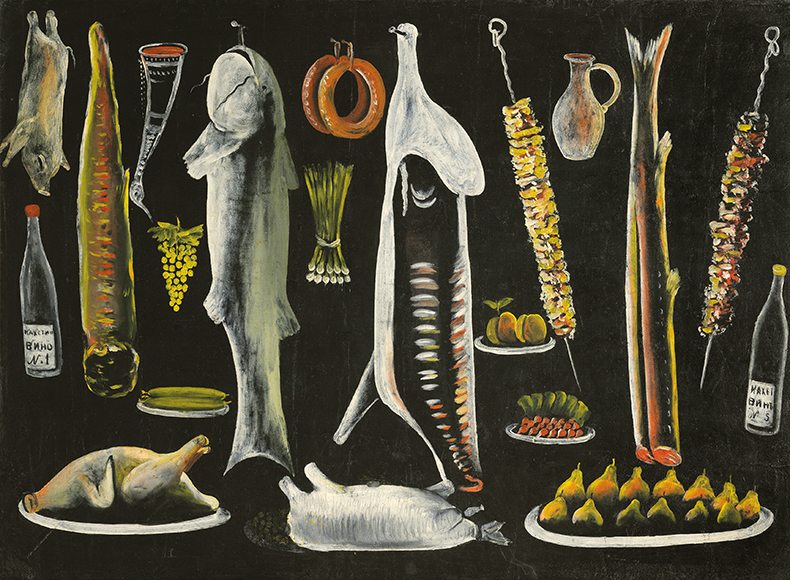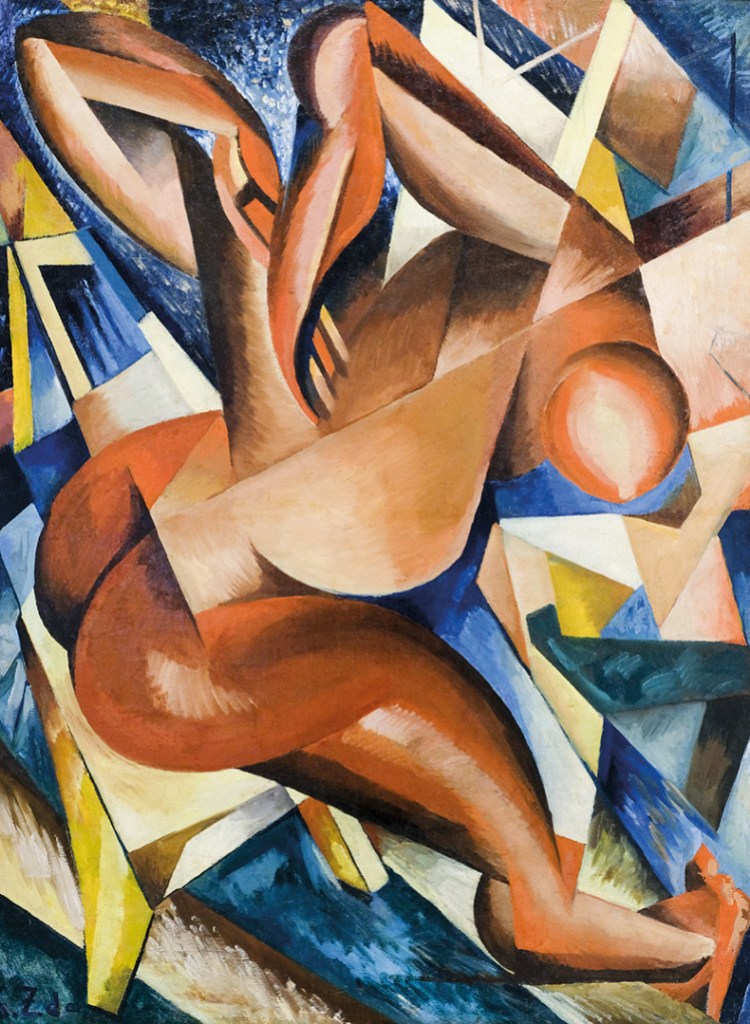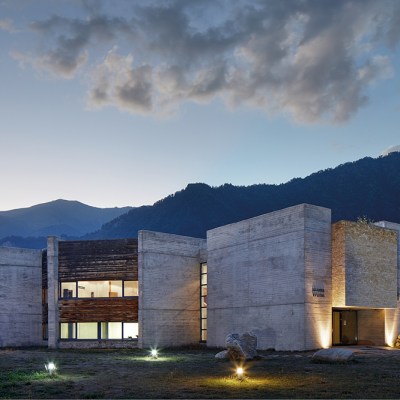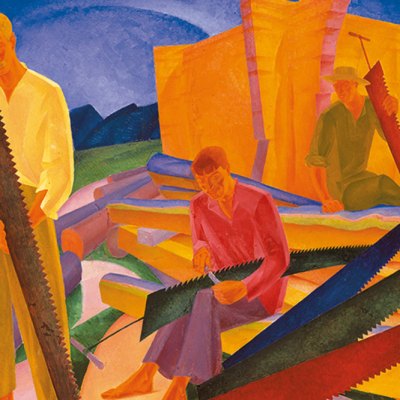From the March 2024 issue of Apollo. Preview and subscribe here.
In the first three decades of the 20th century the city of Tiflis, now Tbilisi, became a cultural crucible whose sparks would fly all over the world. What would come to be known as Georgian Modernism encompassed poetry, film, music and book design, though it is best known for its achievements in theatre and art. The movement would help found the institutions of an independent state. All too soon it would be crushed by Stalin and his secret police chief Lavrentiy Beria – both Georgian products of a different kind of modernism.
For more than 60 years this movement was ignored, even in Georgia. The art history of the period was first falsified, then forgotten. It took decades for dissident scholars and artists to recover the stories and works of the leading lights of Georgian Modernism. Scholars such as Nana Kipiani, a pioneering art historian of the period, have delved into museum storages, theatre archives and personal libraries to reclaim works of dazzling originality. Some are still being unearthed. It is only now, with a recent exhibition at Bozar in Brussels, that this extraordinary legacy is being set out before the rest of the world.
There is, of course, an exception. One Georgian artist from the early 20th century, Nikoloz Pirosmanashvili, known to the world as Pirosmani, has been canonised and is already familiar in the West. Recently the subject of highly regarded exhibitions in Denmark and Switzerland, Pirosmani was the quintessential outsider artist. A peasant who moved to the big city and taught himself to paint pub signs, he lived on the margins of Tiflis, exchanging canvasses for room and board. He is often called a ‘primitivist’, but that belies the considered, singular nature of his work and his well-developed style. In his paintings, black backgrounds and thick lines pick out stylised feasts, religious festivals and exotic animals in a manner that still casts a shadow over Georgian and Russian art more than a century after he died.
Pirosmani, who is a famous name in the countries of the former Soviet Union, was discovered by the very avant-gardists whose history the USSR tried to erase. In 1912, the brothers Ilia and Kirill Zdanevich (who were just 18 and 20 at the time), and their friend Dmitri Shevardnadze, who was 27, chanced on his work in the taverns of Tiflis. They tracked down Pirosmani, who was in his fifties by then, and put on exhibitions of his work in Georgia and Russia. Their discovery was not enough to change the life of the irascible, unclubbable Pirosmani, who would die in penury six years later. But it is emblematic of how the Georgian modernists – unlike their Western counterparts – viewed the arts of past. ‘The European avant-garde rejected everything in the past,’ says Kipiani, who was the consultant for the Bozar exhibition. ‘Here in Georgia it is a little bit different.’
Still Life (n.d.) Niko Pirosmani. Art Museum of Georgia, Tbilisi. Photo: © Infinitart Foundation

In Georgia, for centuries an independent Christian kingdom cut off from Europe by Islamic empires, the feudal era continued until the Russian conquest that began in the late 18th century. Thus, to paraphrase Kipiani, the country bypassed some four centuries of European realism, going directly from the medieval to the modern with brief stops at Romanticism on the way. Pirosmani exemplifies this: his sign boards and tableaux draw equally on the world of steam trains and commerce, and on the stylised traditions of frescoes and icons. For people like Ilia and Kiril Zdanevich, who looked with ambivalence verging on hostility at the previous century of Russian rule in Georgia, Pirosmani was the bridge from the tradition to the avant-garde. Their discovery of him gave birth to a new Georgian canon and served to sanctify the work of the modernists by linking it to an idealised Georgian past. Rather than iconoclasts, these modernists were iconophiles.
The Zdanevich brothers are usually credited with ushering in the Georgian avant-garde, though in the Bozar show Kipiani pushed back a generation before, to the occult-tinged erotica of Gigo Gabashvili. Better known as a realist painter of battle scenes, during his Symbolist phase Gabashvili depicted giant phalluses worshipped by crowds of Rosicrucian devotees against a backdrop of Georgia’s best-known pre-Christian sites. These pieces have never been on display before and point tantalisingly at a body of oil paintings destroyed by fire after Gabashvili’s mysterious death in 1936.
Yet it is the Zdaneviches who are most characteristic of the cosmopolitan, subversive, intellectual society that emerged in Tiflis in the 1910s. The brothers were the descendants of Polish nobility exiled to the Caucasus after the uprising of 1831. Kirill would study art in Russia, exhibiting with Goncharova, Chagall and Malevich, producing cubist portraits and Futurist illustrations. Ilia, a theoretician, writer and designer as well as an artist, would publish newspapers and dozens of art books using typography as a visual language in its own right. The publications of his group, 41º, echo constructivism and the art of the Russian Civil War.
Female Figure (1910s), Kirill Zdanevich. Shalva Amiranashvili State Museum of Fine Arts, Georgian National Museum, Tbilisi. Photo: Hervé Champollion/akg-images

The brothers had returned to Tiflis by 1917, a momentous time in Georgia, when the country was poised to regain its independence after more than a century of Russian rule. The Democratic Republic of Georgia, which lasted from 1918 to 1921, was a glorious, doomed experiment in democracy and freedom of expression. A generation of artists, poets and directors assembled in Tiflis, a refuge from war and revolution, prompting a cultural efflorescence.
Artists such as Lado Gudiashvili, whose elongated, semi-sexualised figures set in darkly inflected Georgian landscapes look like Pirosmani’s bad dream, would collaborate with Kirill Zdanevich and Iakob Nikoladze, a former pupil of Rodin’s, to paint the walls of ‘artistic cafes’. These cafes were essentially avant-garde nightclubs, replete with poetry readings and lectures. ‘Already in the 1910s, it is unlikely that a day passed without some avant-gardist giving a lecture,’ says Kipiani. In venues like the Fantastic Tavern and Kimeroni (‘Chimera’), theory and politics mixed with wine and hedonism.
A single mural cycle survives, from the Kimeroni cafe under the Rustaveli Theatre, Georgia’s main playhouse. One part is by Gudiashvili, while another is by David Kakabadze, a kind of Expressionist and arguably Georgia’s finest painter. Kakabadze’s masterpieces are hymns to Imereti, the verdant region of his birth. In My Mother (1918) we see a foregrounded figure of a woman almost growing out of the lush earth. Fields in the background are picked out in abstract blocks of colour.
During Georgia’s brief period of independence, modernists turned their hand to the creation of a state and its institutions – an unusual line of work for cafe-hopping young artists. Shevardnadze, one of the Pirosmani discoverers, would found the national gallery and art academy and design the national coat of arms. (His crest for the first university in the Caucasus is still in use.) Gudiashvili, Ilia Zdanevich and Mikheil Chiaureli, who would go on to be a director of historical epics in the Stalin era, travelled with historians and ethnographers to record the ornaments and floor plans of Georgian cathedrals in Turkey. Zdanevich designed the book of the expedition, which was published in the USSR without his name.
But the writing was on the wall for the fledgling republic. Already in 1919, the new government had been giving out travel grants to send artists to study in the West. By the time the Bolshevik invasion snuffed out independent Georgia in February 1921, most of the avant-garde were in Paris.
Even in exile, where the Georgians were a drop in the ocean of ‘Russian’ emigrés, the movement continued. Ilia Zdanevich, who would soon adopt the moniker Iliazd, would become a major figure in France, growing close to Picasso and Giacometti. He organised Surrealist galas in the name of Apollo, made fabric designs for Chanel and published a book on Pirosmani, for which Picasso supplied an imagined portrait of the Georgian master.
Ilia would never return to Georgia, where his name and achievements were erased by the new Soviet authorities. He died in 1975, having never exchanged his passport issued by the Democratic Republic of Georgia, a country which had ceased to exist more than 40 years before. Kirill Zdanevich was tempted back to Soviet Georgia, but immediately sought to leave. He would not be allowed to visit his brother in France until 1962.
Kakabadze and Gudiashvili would also return. Gudiashvili would flirt with danger, painting church frescoes during the anti-religious Stalin era, but by the time he died in 1980 his work had been accepted by the authorities. Kakabadze, a scientist by training, had received a patent for a stereoscopic film projector – a 3D cinema device that did not require glasses – and had hoped to develop it in the Soviet Union. Instead, he endured what he would call the ‘years of silence’ before being allowed to paint again.
Kakabadze’s works from the period are some of his most interesting: Expressionism disguised as Socialist Realism. In Demonstration in Imereti (1942), the towering, polychrome hillsides dwarf a crowd holding banners of Stalin, Lenin and Beria. The image of Beria has been crudely painted out in white after his execution in 1953. Kakabadze would pre-decease him by a year, never witnessing the fall of the man who killed so many of his contemporaries.
Untitled (1920), David Kakabadze. Museo Nacional Thyssen-Bornemisza, Madrid. Photo: akg-images

The younger avant-gardists who remained in Tbilisi attempted to find a modus vivendi with the Bolshevik occupiers, still daring to push the limits of artistic theory and practice, albeit from an avowedly leftist position. The best example of this trend is H2SO4, a leftist-Futurist group of radical artists and writers united under the chemical formula for sulphuric acid – as if to dissolve away the bourgeois, corrupt accretions of pre-Revolutionary art. The group took aim at Georgian emigrés, but their eponymous manifesto-magazine, published in 1924, is the apotheosis of the experiments with typography and book design embarked on by Zdanevich and 41º ten years before.
Toleration of avant-gardism would come to an end in 1924, the same year H2SO4 published its magazine, when a popular uprising against the Bolsheviks brought a new wave of repression. From this point on the lectures and the cafes, the exhibitions and the unabashed joy in Georgia’s ancient past, was to be mostly forbidden. There was only one exception: the theatre.
From 1924 until the Great Purge of 1937, Georgia’s avant-garde flourished on the stage under the firebrand director Sandro Akhmeteli and his rival Kote Marjanishvili. A radical leftist and a difficult personality, Akhmeteli baulked at conformity. His theatrical ensemble would end performances singing ancient Georgian hymns to Lile the sun goddess, enrapturing audiences across the USSR.
Akhmeteli’s popularity and left-wing credentials opened a rare space of creative freedom. He took over the Rustaveli Theatre, above the now closed Kimeroni, providing a refuge for an artistic movement already in the sights of the regime. Kirill Zdanevich and Kakabadze provided costumes and sets, from Dada clowns to giant circuit boards. Akhmeteli was tortured and executed by Beria in 1937.
It is in the theatre that we find the last two giants of the Georgian avant-garde. Irakli Gamrekeli was a set designer of genius, whose creations for Marjanishvili and Akhmeteli range from sleek Bauhaus modernism to Expressionistic mountain villages. These designs were some of the highlights of the Bozar show. Some have never been seen outside of Georgia before, and even in Tbilisi almost none of his work is on public display.
Set Design for ‘Masses Man’ (1923), Irakli Gamrekeli. Art Palace of Georgia, Museum of Cultural History, Tbilisi. Photo: Gia Chkhatarashvili and Boris Skrinnikov

Petre Otskheli, on the other hand, is well known today. He was 30 when he was executed in 1937. His work – a small oeuvre of set and costume designs – lay forgotten until the early 2000s when it was unearthed and popularised by the art historian Maia Tsitsishvili. His Sketch for ‘Winged Painter’ is a costume design showing a pilot in a helmet, goggles and a leather flight suit, giving a thumbs up.
Although the sketch is for a 1936 play, it looks like something out of the space age – an image of soaring optimism and modernity. In Georgia the Winged Painter has become a kind of icon. The image appears on posters, picked out in neon lights, on fridge magnets and even on socks. It is a symbol of the Georgia that might have been, of the unfulfilled promise of the avant-garde.
From the March 2024 issue of Apollo. Preview and subscribe here.


